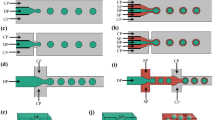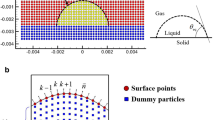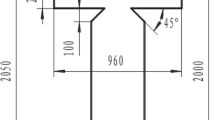Abstract
This work presents a two-dimensional (2D) model employing the mesh-free smoothed particle hydrodynamics (SPH) method for accurate characterization of microdevices. The simulator was validated by comparing analytical and numerical results from literature with the cases of Poiseuille, Couette, and biphase flow in microfluidic devices. Finally, a test case using two immiscible fluids in a cross-like device with three inputs and one output was computed. This device produces droplets in a flow-focusing configuration. The simulations produced similar flows when compared with theoretical, numerical, and experimental data reported in literature. When handling two liquid phases, such as water and oil, properties such as surface tension must be taken into account. These properties can be well modeled using the continuum surface force method, commonly applied for modeling capillarity in microdevice and microliquid applications. Thus, the implementation of the SPH method demonstrated that it represents a novel and promising alternative for simulation of emulsion formation in microfluidic devices.





















Similar content being viewed by others
References
Nisar A, Afzulpurkar N, Mahaisavariya B, Tuantranont A (2008) MEMS-based micropumps in drug delivery and biomedical applications. Sens Actuators B 130(2):917–942
Cheng J, Kricka L, Sheldon E, Wilding P (1998) Sample preparation in microstructured devices. Microsyst Technol Chem Life Sci 194:215–231
Filipovic N, Ivanovic M, Kojic M (2008) A comparative numerical study between dissipative particle dynamics and smoothed particle hydrodynamics when applied to simple unsteady flows in microfluidics. Microfluid Nanofluid 7(2):227–235
Gifford SC, Spillane AM, Vignes SM, Shevkoplyas SS (2014) Controlled incremental filtration: a simplified approach to design and fabrication of high-throughput microfluidic devices for selective enrichment of particles. Lab Chip 14(23):4496–505
Ehrfeld W (2003) Electrochemistry and microsystems. Electrochim Acta 48(20–22):2857–2868
Xia H, Strachan BC, Gifford SC, Shevkoplyas SS (2016) A high-throughput microfluidic approach for 1000-fold leukocyte reduction of platelet-rich plasma. Sci Rep 6(1):35,943
Andersson H, van den Berg A (2004) Microtechnologies and nanotechnologies for single-cell analysis. Curr Opin Biotechnol 15(1):44–9
Dong B, Chen S, Zhou F, Chan CHY, Yi J, Zhang HF, Sun C (2016) Real-time functional analysis of inertial microfluidic devices via spectral domain optical coherence tomography. Sci Rep 6(1):33,250
Berthier J, Silberzan P (2010) Microfluidics for biotechnology. Artech House
Shah RK, Shum HC, Rowat AC, Lee D, Agresti JJ, Utada AS, Ly Chu, Kim W, Fernandez-Nieves A, Martinez CJ, Weitz DA, Kim JW (2008) Designing emulsions using microfluidics. Mater Today 11(4):18–27
Squires TM, Quake SR (2005) Microfluidics: fluid physics at the nanoliter scale. Rev Mod Phys 77(3):977–1026
Amini H, Lee W, Di Carlo D (2014) Inertial microfluidic physics. Lab Chip 14(15):2739
Kunstmann-Olsen C, Hoyland JD, Rubahn HG (2012) Influence of geometry on hydrodynamic focusing and long-range fluid behavior in PDMS microfluidic chips. Microfluid Nanofluid 12(5):795–803
Hetsroni G, Mosyak A, Pogrebnyak E, Yarin LP (2005) Fluid flow in micro-channels. Int J Heat Mass Transf 48(10):1982–1998
Spielman LGS (1968) Improving resolution in coulter counting by hydrodynamic focusing. J Colloid Interface Sci 26(2):175–182
de Mello AJ, Edel JB (2007) Hydrodynamic focusing in microstructures: Improved detection efficiencies in subfemtoliter probe volumes. J Appl Phys 101(8):084,903
Shen M, Yamahata C, Gijs MAM (2008) A high-performance compact electromagnetic actuator for a PMMA ball-valve micropump. J Micromech Microeng 18(2):025,031
Bourouina T, Grandchamp J (1996) Modeling micropumps with electrical equivalent networks. J Micromech Microeng 6(4):398–404
Jamalabadi MYA, DaqiqShirazi M, Kosar A, Shadloo MS (2017) Effect of injection angle, density ratio, and viscosity on droplet formation in a microfluidic T-junction. Theor Appl Mech Lett 7(4):243–251
Clift RR, Grace JR, Weber ME (1978) Bubbles, drops and particles. Academic Press, New York
Bruus H (2008) Theoretical microfluidics. Oxford University Press, Oxford
Zhang A, Ming F, Cao X (2014) Total Lagrangian particle method for the large-deformation analyses of solids and curved shells. Acta Mech 225(1):253–275
Taeibi-Rahni M, Karbaschi M, Miller R (2015) Computational methods for complex liquid-fluid interfaces. CRC Press, Boca Raton
He L, Seaid M (2016) A Runge–Kutta–Chebyshev SPH algorithm for elastodynamics. Acta Mech 227(7):1813–1835
Liu MB, Liu GR, Zong Z (2008) An overview on smoothed particle hydrodynamics. Int J Comput Methods 05(01):135–188
Shadloo M, Oger G, Le Touzé D (2016) Smoothed particle hydrodynamics method for fluid flows, towards industrial applications: motivations, current state, and challenges. Comput Fluids 136:11–34
Zhang ZL, Liu MB (2018) A decoupled finite particle method for modeling incompressible flows with free surfaces. Appl Math Model 60:606–633
Bonet J, Kulasegaram S (2000) Correction and stabilization of smooth particle hydrodynamics methods with applications in metal forming simulations. Int J Numer Methods Eng 47(6):1189–1214
Liu MB, Liu GR (2016) Particle methods for multi-scale and multi-physics. World Scientific, Singapore
Liu L, Yan H, Zhao G, Zhuang J (2016) Experimental studies on the terminal velocity of air bubbles in water and glycerol aqueous solution. Exp Therm Fluid Sci 78:254–265
Español P, Revenga M (2003) Smoothed dissipative particle dynamics. Phys Rev E 67(2):1–12
Zhi-bin W, Rong C, Hong W, Qiang L, Xun Z, Shu-zhe L (2016) An overview of smoothed particle hydrodynamics for simulating multiphase flow. Appl Math Model 40:9625–9655
Tartakovsky A, Meakin P (2005) Modeling of surface tension and contact angles with smoothed particle hydrodynamics. Phys Rev E 72(2):026,301
Vázquez-Quesada A, Ellero M, Español P (2012) A SPH-based particle model for computational microrheology. Microfluid Nanofluid 13(2):249–260
Müller K, Fedosov DA, Gompper G (2015) Smoothed dissipative particle dynamics with angular momentum conservation. J Comput Phys 281:301–315
Fedosov DA, Peltomäki M, Gompper G (2014) Deformation and dynamics of red blood cells in flow through cylindrical microchannels. Soft Matter 10(24):4258–4267
Karunasena HCP, Senadeera W, Gu YT, Brown RJ (2014) A coupled SPH-DEM model for micro-scale structural deformations of plant cells during drying. Appl Math Model 38(15–16):3781–3801
Chen JK, Beraun JE, Carney TC (1999) A corrective smoothed particle method for boundary value problems in heat conduction. Int J Numer Methods Eng 46(2):231–252
Liu WK, Jun S, Li S, Adee J, Belytschko T (1995) Reproducing kernel particle methods for structural dynamics. Int J Numer Methods Eng 38(10):1655–1679
Tartakovsky AM, Meakin P, Scheibe TD, Wood BD (2007) A smoothed particle hydrodynamics model for reactive transport and mineral precipitation in porous and fractured porous media. Water Resour Res 43(5):1–18
Nugent S, Posch H (2000) Liquid drops and surface tension with smoothed particle applied mechanics. Phys Rev E Stat Phys Plasmas Fluids Relat Interdiscip Top 62(4 Pt A):4968–75
Morris JP (2000) Simulating surface tension with smoothed particle hydrodynamics. Int J Numer Methods Fluids 33(3):333–353
Wu J, Yu ST, Bn Jiang (1998) Simulation of two-fluid flows by the least-squares finite element method using a continuum surface tension model. Int J Numer Methods Eng 42(4):583–600
Liu MB, Liu GR (2004) Meshfree particle simulation of micro channel flows with surface tension. Comput Mech 35(5):332–341
Liu MB, Liu GR (2010) Smoothed particle hydrodynamics (SPH): an overview and recent developments. Arch Comput Methods Eng 17(1):25–76
Tartakovsky AM, Panchenko A (2016) Pairwise force smoothed particle hydrodynamics model for multiphase flow: surface tension and contact line dynamics. J Comput Phys 305:1119–1146
Violeau D, Rogers BD (2016) Smoothed particle hydrodynamics (SPH) for free-surface flows: past, present and future. J Hydraul Res 1689(January):1–26
Mokos A, Rogers BD, Stansby PK, Dominguez JM (2015) Multi-phase SPH modelling of violent hydrodynamics on GPUs. Comput Phys Commun 196:304–316
Grenier N, Le Touze D, Colagrossi A, Antuono M, Colicchio G (2013) Viscous bubbly flows simulation with an interface SPH model. Ocean Eng 69:88–102
Xu X, Ouyang J, Jiang T, Li Q (2014) Numerical analysis of the impact of two droplets with a liquid film using an incompressible SPH method. J Eng Math 85(1):35–53
Shadloo MS, Yildiz M (2011) Numerical modeling of Kelvin–Helmholtz instability using smoothed particle hydrodynamics. Int J Numer Methods Eng 87(10):988–1006
Koukouvinis PK, Anagnostopoulos JS, Papantonis DE (2013) Simulation of 2D wedge impacts on water using the SPH-ALE method. Acta Mech 224(11):2559–2575
Shadloo MS, Zainali A, Yildiz M (2013) Simulation of single mode Rayleigh–Taylor instability by SPH method. Comput Mech 51(5):699–715
Adami S, Hu X, Adams N (2010) A new surface-tension formulation for multi-phase SPH using a reproducing divergence approximation. J Comput Phys 229(13):5011–5021
Hua J, Stene JF, Lin P (2008) Numerical simulation of 3D bubbles rising in viscous liquids using a front tracking method. J Comput Phys 227(6):3358–3382
Hu X, Adams N (2006) A multi-phase SPH method for macroscopic and mesoscopic flows. J Comput Phys 213(2):844–861
Szewc K, Pozorski J, Tanire A (2011) Modeling of natural convection with smoothed particle hydrodynamics: non-Boussinesq formulation. Int J Heat Mass Transf 54(23–24):4807–4816
Molteni D, Colagrossi A (2009) A simple procedure to improve the pressure evaluation in hydrodynamic context using the SPH. Comput Phys Commun 180(6):861–872
Oger G, Marrone S, Le Touzé D, de Leffe M (2016) SPH accuracy improvement through the combination of a quasi-Lagrangian shifting transport velocity and consistent ALE formalisms. J Comput Phys 313:76–98
Szewc K, Pozorski J, Minier JP (2013) Simulations of single bubbles rising through viscous liquids using smoothed particle hydrodynamics. Int J Multiph Flow 50:98–105
Adami S, Hu XY, Adams NA (2013) A transport-velocity formulation for smoothed particle hydrodynamics. J Comput Phys 241:292–307
Anderson JDJ (1995) Computational fluid dynamics: the basics with applications. McGraw-Hill, New York
Morris JP, Fox PJ, Zhu Y (1997) Modeling low reynolds number incompressible flows using SPH. J Comput Phys 136(1):214–226
Batchelor GK, Young AD (1968) An introduction to fluid mechanics, vol 35. Cambridge University Press, Cambridge
Brackbill JU, Kothe DB, Zemach C (1992) A continuum method for modeling surface tension. J Comput Phys 100(2):335–354
Adami S, Hu XY, Adams N (2012) A generalized wall boundary condition for smoothed particle hydrodynamics. J Comput Phys 231(21):7057–7075
Hu XY, Adams NA (2007) An incompressible multi-phase SPH method. J Comput Phys 227(1):264–278
Grenier N, Antuono M, Colagrossi A, Le Touzé D, Alessandrini B (2009) An Hamiltonian interface SPH formulation for multi-fluid and free surface flows. J Comput Phys 228(22):8380–8393
Shadloo MS, Rahmat A, Yildiz M (2013) A smoothed particle hydrodynamics study on the electrohydrodynamic deformation of a droplet suspended in a neutrally buoyant Newtonian fluid. Comput Mech 52(3):693–707
Klostermann J, Schaake K, Schwarze R (2013) Numerical simulation of a single rising bubble by VOF with surface compression. Int J Numer Methods Fluids 71(8):960–982
Ming FR, Sun PN, Zhang AM (2017) Numerical investigation of rising bubbles bursting at a free surface through a multiphase SPH model. Meccanica 52(11–12):2665–2684
Saitoh TR, Makino J (2013) A density-independent formulation of smoothed particle hydrodynamics. Astrophys J 768(1):44
Gomez-Gesteira M, Rogers BD, Ra Dalrymple, Crespo AJ (2010) State-of-the-art of classical SPH for free-surface flows. J Hydraul Res 48(sup1):6–27
Monaghan J (1994) Simulating free surface flows with SPH. J Comput Phys 110(2):399–406
Zhang A, Sun P, Ming F (2015) An SPH modeling of bubble rising and coalescing in three dimensions. Comput Methods Appl Mech Eng 294(145):189–209
Sadeghi R, Shadloo MS, Hopp-Hirschler M, Hadjadj A, Nieken U (2018) Three-dimensional lattice Boltzmann simulations of high density ratio two-phase flows in porous media. Comput Math Appl 75(7):2445–2465
Yeganehdoust F, Yaghoubi M, Emdad H, Ordoubadi M (2016) Numerical study of multiphase droplet dynamics and contact angles by smoothed particle hydrodynamics. Appl Math Model 40(19–20):8493–8512
Layzer D (1955) On the instability of superposed fluids in a gravitational field. Astrophys J 122:1
Dalziel SB (2001) Toy models for Rayleigh–Taylor instability. In: 8th international workshop on the physics of compressible turbulent mixing. Lawrence Livermore National Laboratory Publication, UCRL-MI-146350, p Paper T10
Goncharov VN (2002) Analytical model of nonlinear, single-mode, classical Rayleigh–Taylor instability at arbitrary Atwood numbers. Phys Rev Lett 88(13):134,502
Abarzhi S, Nishihara K, Glimm J (2003) Rayleigh–Taylor and Richtmyer–Meshkov instabilities for fluids with a finite density ratio. Phys Lett A 317(5–6):470–476
Amaya-Bower L, Lee T (2010) Single bubble rising dynamics for moderate Reynolds number using Lattice Boltzmann Method. Comput Fluids 39(7):1191–1207
Zhang Q, Guo W (2015) Universality of finger growth in two-dimensional Rayleigh–Taylor and Richtmyer–Meshkov instabilities with all density ratios. J Fluid Mech 786:47–61
Abarzhi S (2003) The effect of the density ratio on the nonlinear dynamics of the unstable fluid interface. In: Center for turbulence research annual research briefs, pp 251–260
Ramaprabhu P, Dimonte G (2005) Single-mode dynamics of the Rayleigh–Taylor instability at any density ratio. Phys Rev E Stat Nonlinear Soft Matter Phys 71(3):1–9
Choi S, Sohn SI (2017) Multi-harmonic models for bubble evolution in the Rayleigh–Taylor instability. J Korean Math Soc 54(2):663–673
Monaghan JJ, Rafiee A (2013) A simple SPH algorithm for multi-fluid flow with high density ratios. Int J Numer Methods Fluids 71(5):537–561
Hysing S, Turek S, Kuzmin D, Parolini N, Burman E, Ganesan S, Tobiska L (2009) Quantitative benchmark computations of two-dimensional bubble dynamics. Int J Numer Methods Fluids 60:1259–1288
Litvinov S, Ellero M, Hu X, Adams N (2010) A splitting scheme for highly dissipative smoothed particle dynamics. J Comput Phys 229(15):5457–5464
Taylor GI (1934) The formation of emulsions in definable fields of flow. Proc R Soc Lond A: Math Phys Eng Sci 146(858):501–523
Cheng L, Ribatski G, Thome JR (2008) Two-phase flow patterns and flow-pattern maps: fundamentals and applications. Appl Mech Rev 61(050):802
Dutta R (2008) Fundamentals of biochemical engineering. Ane Books India, New Delhi
Shadloo MS, Zainali A, Sadek SH, Yildiz M (2011) Improved incompressible smoothed particle hydrodynamics method for simulating flow around bluff bodies. Comput Methods Appl Mech Eng 200(9–12):1008–1020
Zhou L, Cai ZW, Zong Z, Chen Z (2016) An SPH pressure correction algorithm for multiphase flows with large density ratio. Int J Numer Methods Fluids 81(12):765–788
Duan G, Koshizuka S, Chen B (2015) A contoured continuum surface force model for particle methods. J Comput Phys 298:280–304
Breinlinger T, Polfer P, Hashibon A, Kraft T (2013) Surface tension and wetting effects with smoothed particle hydrodynamics. J Comput Phys 243:14–27
Zhang M, Deng XL (2015) A sharp interface method for SPH. J Comput Phys 302:469–484
Acknowledgements
The authors are grateful to FAPESP and CNPq foundation and to Labmulti (IFGW) Unicamp for laser writing technical support, as well as to the Center for Computational Engineering and Sciences (CCES-CEPID/UNICAMP) for support of computational facilities. E.A.P.-N. is grateful to FAPESP for financial support of his PhD (process no. 2012/21090-5).
Author information
Authors and Affiliations
Corresponding author
Additional information
Publisher's Note
Springer Nature remains neutral with regard to jurisdictional claims in published maps and institutional affiliations.
Rights and permissions
About this article
Cite this article
Patino-Narino, E.A., Idagawa, H.S., de Lara, D.S. et al. Smoothed particle hydrodynamics simulation: a tool for accurate characterization of microfluidic devices. J Eng Math 115, 183–205 (2019). https://doi.org/10.1007/s10665-019-09998-2
Received:
Accepted:
Published:
Issue Date:
DOI: https://doi.org/10.1007/s10665-019-09998-2




